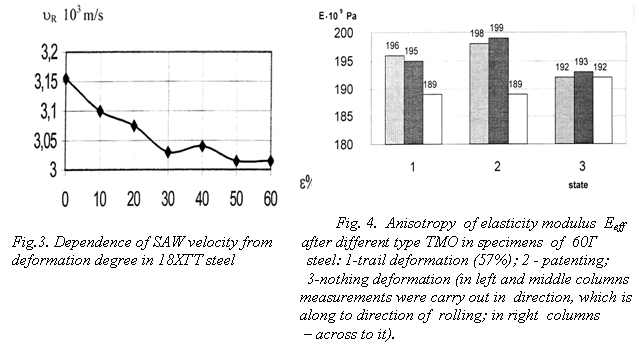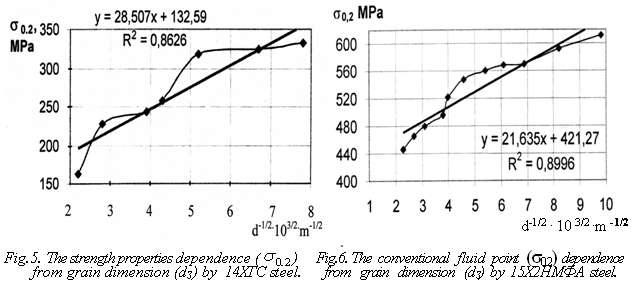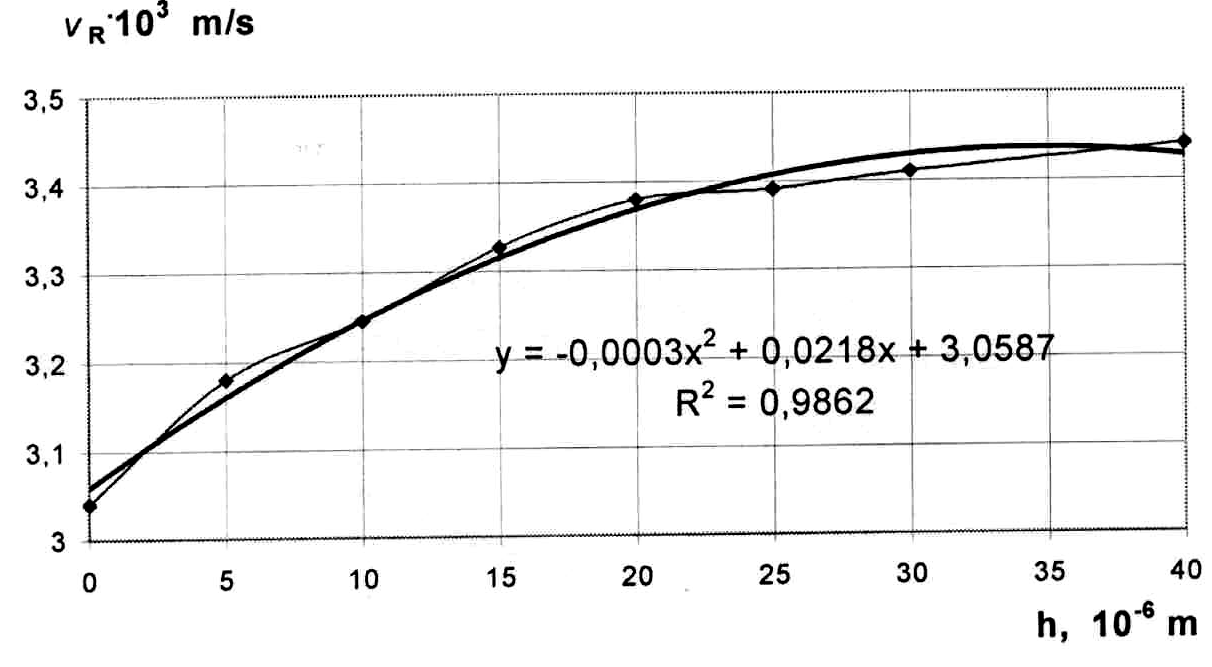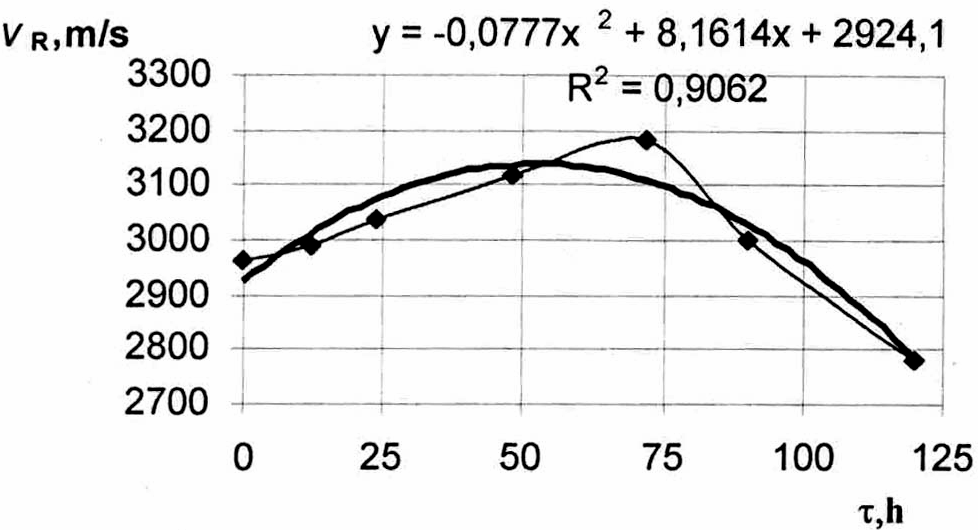АКУСТОМИКРОСКОПИЧЕСКИЕ МЕТОДЫ: ИЗУЧЕНИЕ СТРУКТУРНЫХ ПАРАМЕТРОВ И ФИЗИЧЕСКИХ СВОЙСТВ МЕТАЛЛИЧЕСКИХ МАТЕРИАЛОВ
А.I. Kustov
Voronezh State Pedagogical University
I.А. Migel
Voronezh education and science center of Military Air Forces
THE ACOUSTOMICROSCOPY METHODS FOR STUDY OF STRUCTURAL PARAMETRES AND PHYSICAL PROPERTIES OF METAL MATERIALS
Abstract Dependences of physical-mechanical properties from structural parameters of material play very important role. The paper deals with the perspectives of the application of acoustic microscopy methods for studying the changes of physical - mechanical properties of materials in a condensed state under external influence. The basic principles of the methods as well as the results of the experiments of studying the structure of materials in a condensed state and its transformation upon changing the composition and types of thermomechanical treatment are given in the article. The high sensitivity to non-heterogeneity and defects upon acoustic visualization and in the regime of determining physic-mechanical properties are demonstrated. Keywords: method of visualization, acoustic microscopy, subsurface layers, nanopore density, physical-mechanical steel parameters, nondestructive evaluation.А.И. Kустов
Воронежский государственный педагогический университет
И.А. Mигель
Воронежский учебно-научный центр ВВА им. Н.Жуковского и Ю.Гагарина,
АКУСТОМИКРОСКОПИЧЕСКИЕ МЕТОДЫ: ИЗУЧЕНИЕ СТРУКТУРНЫХ ПАРАМЕТРОВ И ФИЗИЧЕСКИХ СВОЙСТВ МЕТАЛЛИЧЕСКИХ МАТЕРИАЛОВ
Аннотация В работе приведены результаты экспериментов по использованию методов акустомикроскопической дефектоскопии для измерения физико-механических параметров материалов в конденсированном состоянии, прежде всего сталей. Рассмотрено влияние некоторых характеристик внешних воздействий на структуру материала и изменение его свойств. Показано, что расчёт параметров материалов с использованием различных акустомикроскопических методов даёт результаты, совпадающие в пределах погрешностей. Применение методов АМД позволяет существенно расширить количество получаемой информации о материалах и их свойствах, повысить её достоверность и надёжность. Ключевые слова: метод визуализации структуры; акустическая микроскопия; подповерхностные слои; неразрушающий контроль; предельное состояние материала; физико-механические параметры сталей.- Introduction In this paper the results of experimental work of investigation of physical-mechanical properties materials with the help of scanning acoustic microscope (SAM) [1,2] are given. The essence of the subjected methods is first inlayer visualization of subsurface structures of the objects under investigation and second in the definition of velocity values of acoustic waves and calculate the elasticity constant of solid material. The nondestructive methods of investigation of structure and characteristics used have no limits by the nature of materials, including nanostructural materials. They are often different characteristics of physical – mechanical properties.
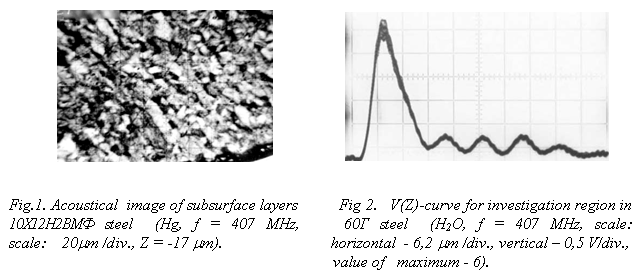 V(Z)-method allow to determine some physical-mechanical parameters (uR, E, G, DV/V%) [3,4]. In according to principles as account earlier [5,6], obtained curve permit to determine the significance of velocities (uR) of surface acoustic waves (SAW). For this calculation we use characteristic distance (DZN ) between maximums, situated on the right of the main one. In order to calculate the value of the elastic modules in the local area of the studied material one should use the tabular values rS of density and of Poisson coefficient (n), or their quantity, determined by one of the certain standard methods. V(Z)-curve method allow to distinguish quantity properties of steel with different extent of deformation or to conduct texture characterization [7].
V(Z)-method allow to determine some physical-mechanical parameters (uR, E, G, DV/V%) [3,4]. In according to principles as account earlier [5,6], obtained curve permit to determine the significance of velocities (uR) of surface acoustic waves (SAW). For this calculation we use characteristic distance (DZN ) between maximums, situated on the right of the main one. In order to calculate the value of the elastic modules in the local area of the studied material one should use the tabular values rS of density and of Poisson coefficient (n), or their quantity, determined by one of the certain standard methods. V(Z)-curve method allow to distinguish quantity properties of steel with different extent of deformation or to conduct texture characterization [7].
- Results and discussion The main task of our investigation was elaboration and use of me-thods of structural parameter definition of metal materials, for example, grain size. Our aim was also establishment of correlation dependences with physic-mechanical properties. The most effective methods were acoustomicroscopy defectoscopy ones. SAM of the reflective type was used to solve the task. The frequency of operation of the microscope was 400-600 MHz.
Received dependences s0,2 from dЗ are in good accordance with low Hall - Peach:
s0,2 = s0 + k dз-1/2 , (3)
were k and s0 – the constant for that material.
However, we due to turn the attention at the fact, that the experimental curve has break by d3 = 40 mm (with linear correlation coefficient ~ 0,9). The nature of this break demand further investigation. Analogical dependence was obtained for 15Х2НМФА steel too (fig.6). If we estimated grain dimension from acoustic image, then we calculate critical significance s0,2 for this material. That significance may be to determine with method V(Z)-curve. Since change of grain dimension transforms value of SAW velocity. Dependence uR from dЗ are demonstrated in fig.7. That allow define s0,2 and grain dimensions from uR measuring. Obtained dependence is similar to straight line, but the approximely coefficient for logarithmic curve is some above, then it (0,97). Consequently, application of AMD methods allows to control strength properties of steel with the help of value dimension. The high reliability of the results is provided for using 2 parallel methods (visualization and V(Z)- curves).The first is based on d3 dimension and using Hall-Peach law. The second is connected with using V(Z)-curves definite values uR and solid modules (E and G) calculations. Application of these methods for steel 14 ХГС (s0 =134 МПа, k = 23 МПа.мм1/2; r = 7,83.103 кг/м3; = 0,27) resulted in s0,2 close values of 249 and 241 correspondingly.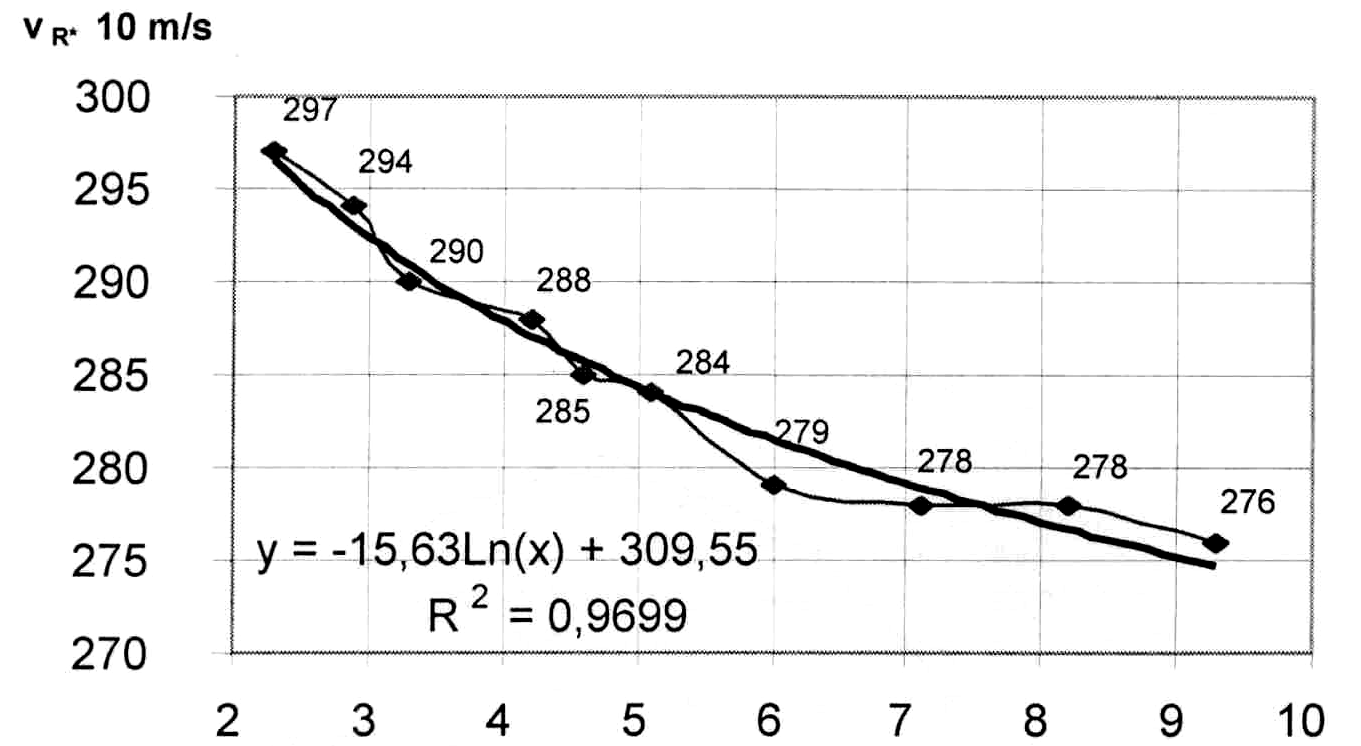 d-1/2 . 10 3/2 .m -1/2
d-1/2 . 10 3/2 .m -1/2
Fig. 7. The velocity (uR) dependence from grain dimension (dЗ) by 15Х2НМФА steel.
Fig. 8. The dependence of SAW velocity (uR) in steel (08Х18Н10Т) on the depth penetration.
Besides physic-mechanical parameter material dependences on grain dimension, the methods AMD allow to estimate the depth of penetration to the material of diffusion substance, layer thickness with changed properties. It is also possible to apply acoustic microscopy methods based on the use of V(Z) – curves for the study of the limit state of the materials in a solid state. It makes it possible to calculate the values of velocities SAW and to define the quantity of the coefficient changes of AW fading in the material at the relative modification DV/V% of height of the main maximum of the V(Z) – curves. The control technology of limit state with appliance of V(Z) – curves consists of the analysis of their form transformation. The values of velocities of surface acoustic waves (SAW) and the change of the level of their fading were calculated due to the special dependencies. The limit state of material conclusion was made according to the dimension of local fluctuations of physical – mechanical parameters. The results of the experiments illustrating the possibility to define the thickness of the modified layer caused by hydrogen diffusion in the metal materials according to the value of velocity SAW or the ratio DV/V% were presented before. The difference between the initial and modified material according to these characteristics can reach 5 – 20%. The results of modeling experimental for nitrogen steel are presented in fig. 8 (steel 08Х18Н10Т). Obtained experimental curve uR are approximated by parabolic dependence with coefficient 0,986. We can to ensure definition depth of transformed layer, if shell analyses that dependence. It is possible to estimate the value and some other sample characteristics, for example the hydrogen concentration, according to the changes of the velocity SAW and the relative height DV/V% of the maximum V(Z) – curve. The depth of penetration, at which the chosen characteristics is 90% of the values inside the material, can be the criterion of the time estimation of diffusion process ( Fig.8).The example of the process for steel 40XH is given in Figure 9. Presence the extreme on its allows to use mathematical (computer) methods of optimal time of influence search. The dependencies both between the hydrogen concentration and the number of the microcracks emerged, and the values of velocity SAW on depth of the hydrogen penetration into the sample, period of diffusion, etc. are received at that. The limit hydrogen concentration in this material can be evaluated concerning the value of velocity SAW from the received dependence for steel. In Fig.9 presented curve of uR - dependence from time exposure of steel (40ХН) specimens in hydrogen. The optimum time dimensions are in interval -~55-67 h.Fig. 9. Dependence of SAW velocity from time exposure (t) of steel specimens in hydrogen.
- Conclusion Thus:
References
- Wilson R.G., Weglein R.D. (1994) Acoustic microscopy of materials and surface layers // Appl. Phys. T. 55. N 9. 3261-3275.
- Kustov А.1. (1994) Study of structure and physical-mechanical properties of solid materials by the acoustomicroscope methods // Materials of VII Rus. conf. "Damped materials", P. 89-97.
- Budanov А.V., Kustov А.I., Migel I.А. (2004) The Study of Changes of Physical - Mechanical Properties of Materials and Condensed State.// Hydrogen materials science..., OTAN Science Series, II. Mathematics, Physics..., v. 72, 203-215.
- Kustov А.1., Migel I.А., Sukhodolov В.G. (1998) Study of effect of different types of heat mechanical treatment on structure and properties of steels and alloys // MиTOM, N4, 128-137.
- Budanov А.V., Kustov А.I., Migel I.А. (2002) The study of the effect of hydrogen on physical-mechanical properties of steel by acoustic microscopy methods // Hydrogen materials science, OTAN Science Series, II. Mathematics, Physics, v.71, 131-140.
- Kustov А.1. Detection of inhomogenetics by acoustomicroscope methods // Fiz. i khim. stekla, 1998 - T. 24, N 6, 809-816.
- Kustov А.I., Migel I.А. Investigation of the physical properties of materials for fuel elements and work up of limit state criteria...// NATO materials science, Science Series, A: Chemistry and Biology, 2007, p. 451-458.

